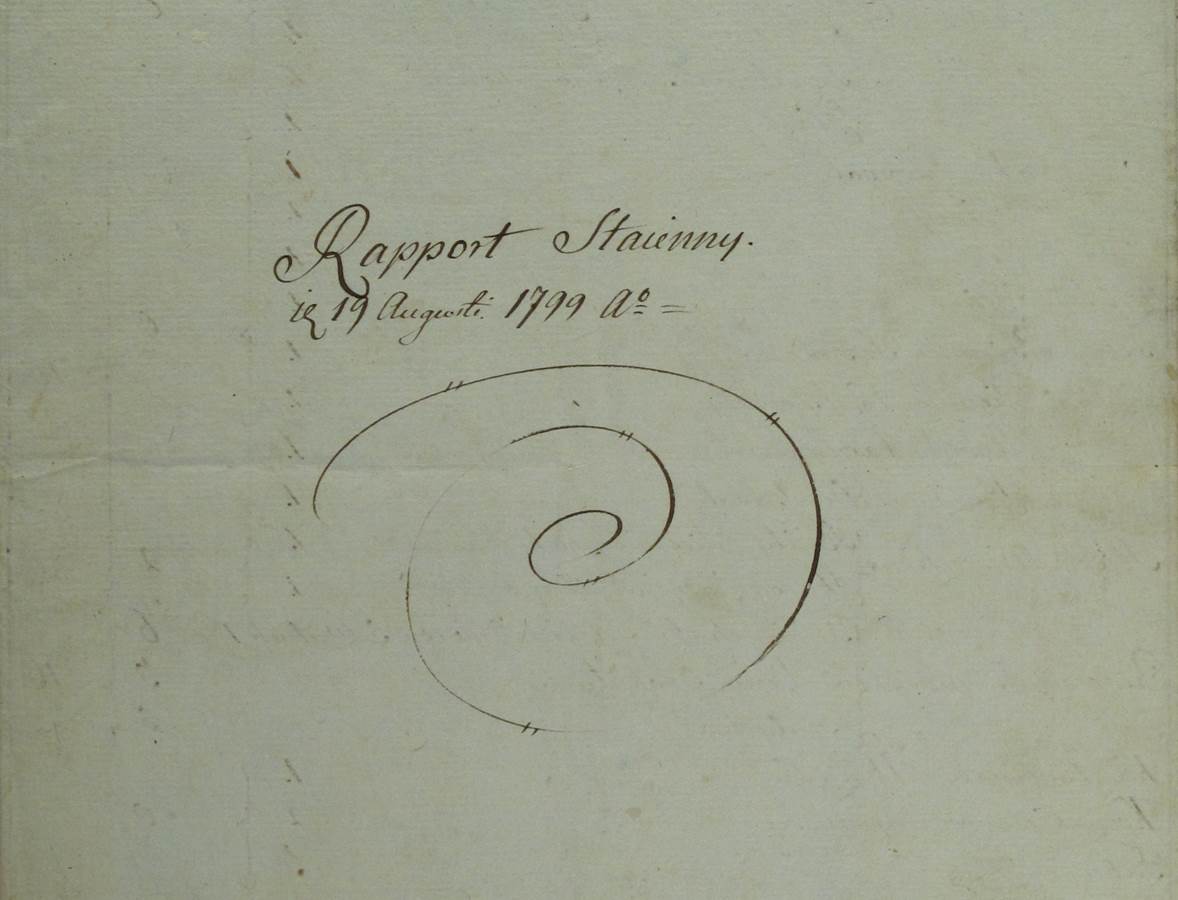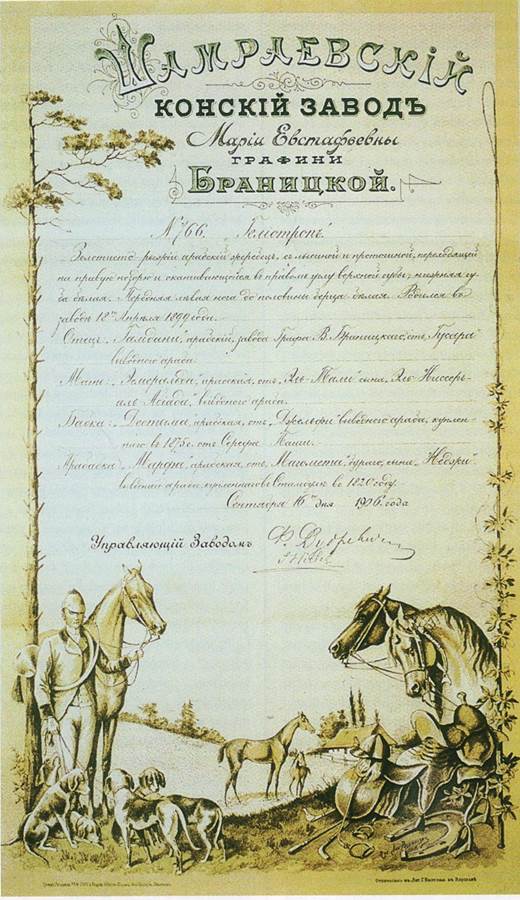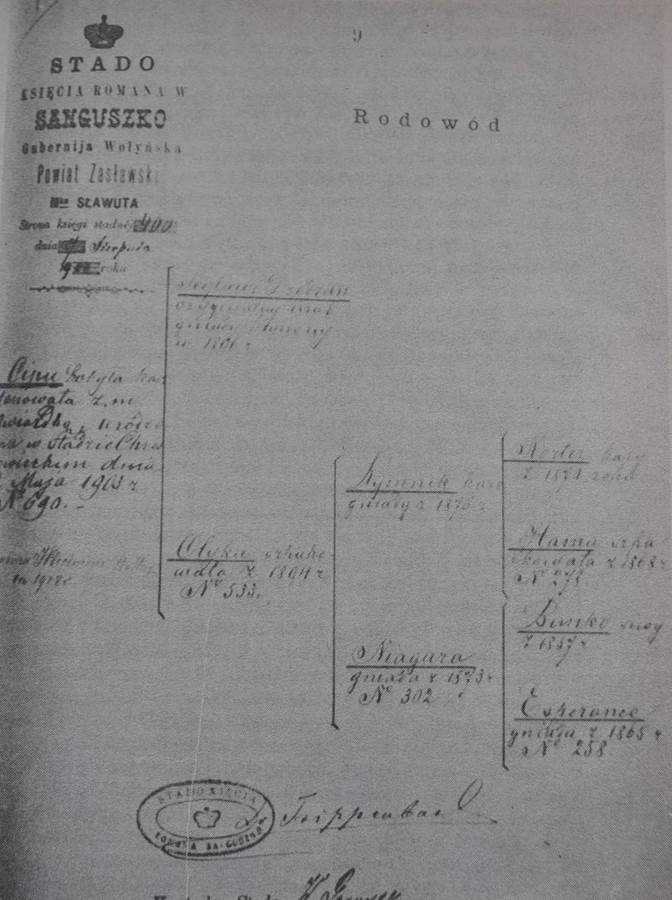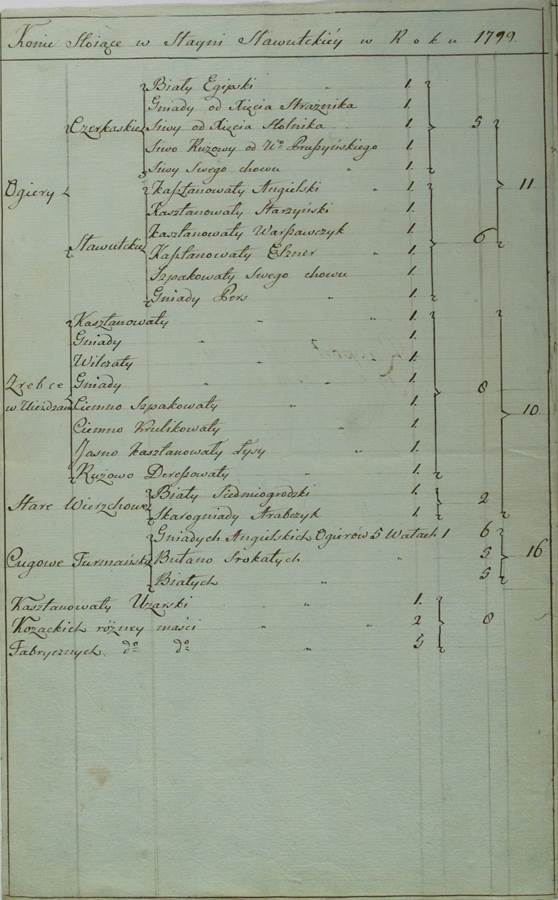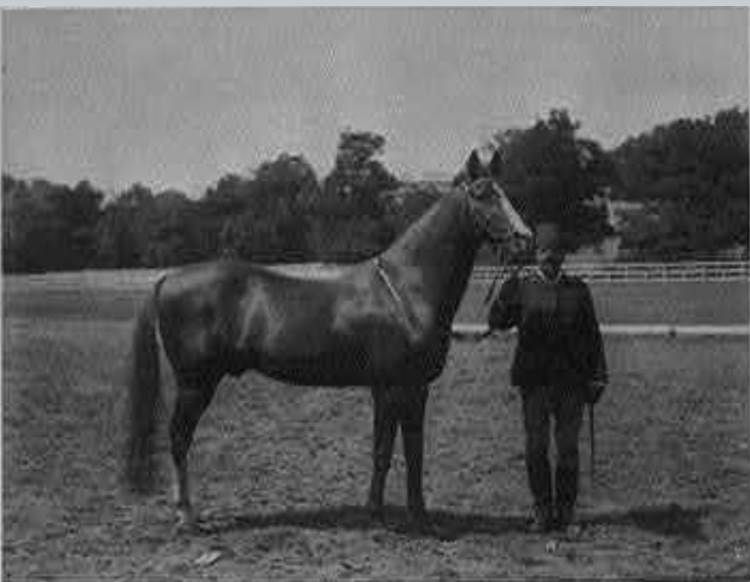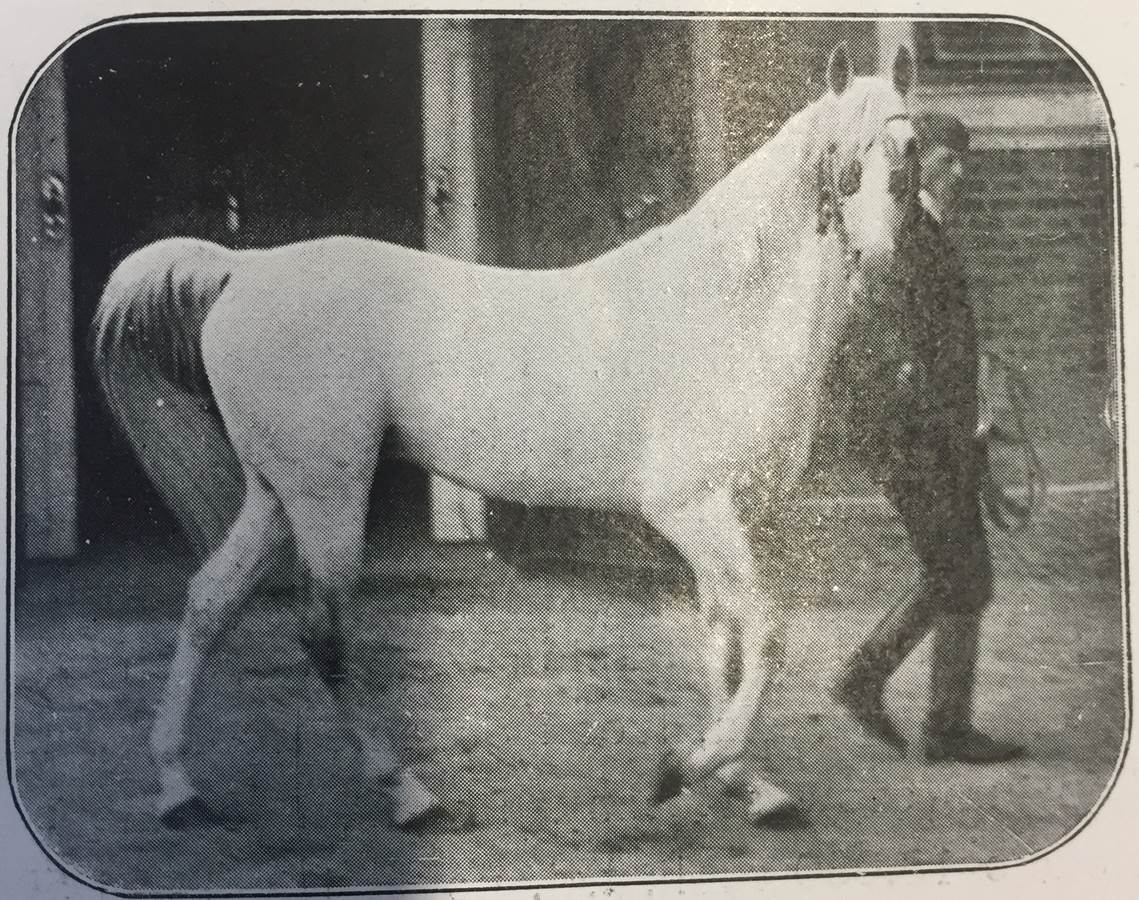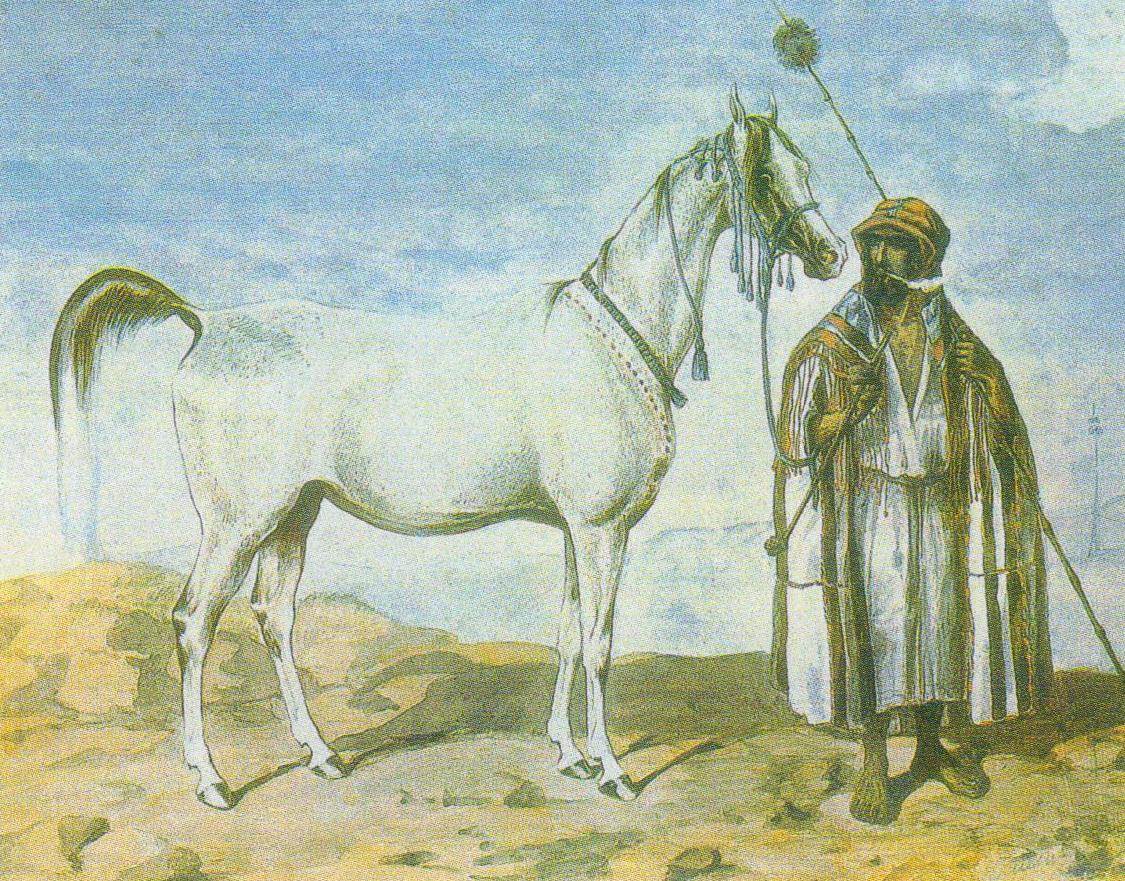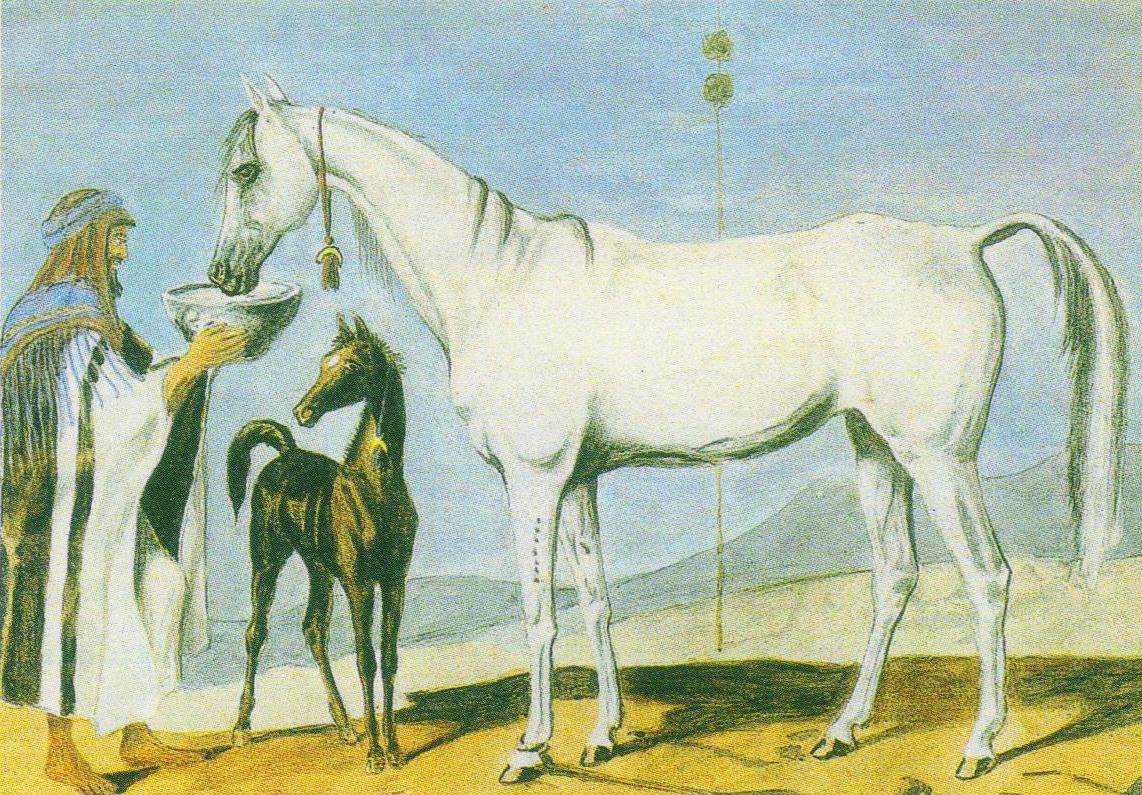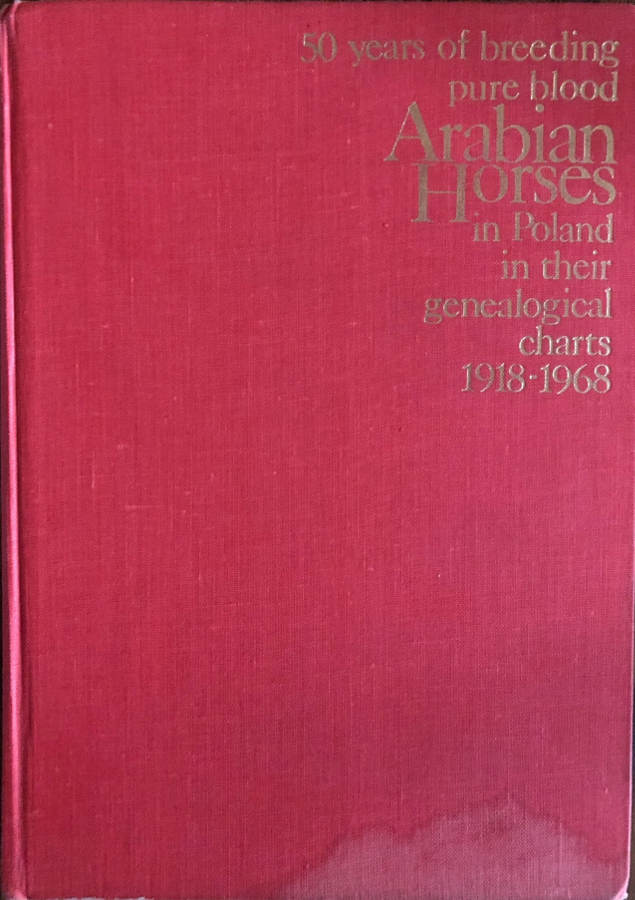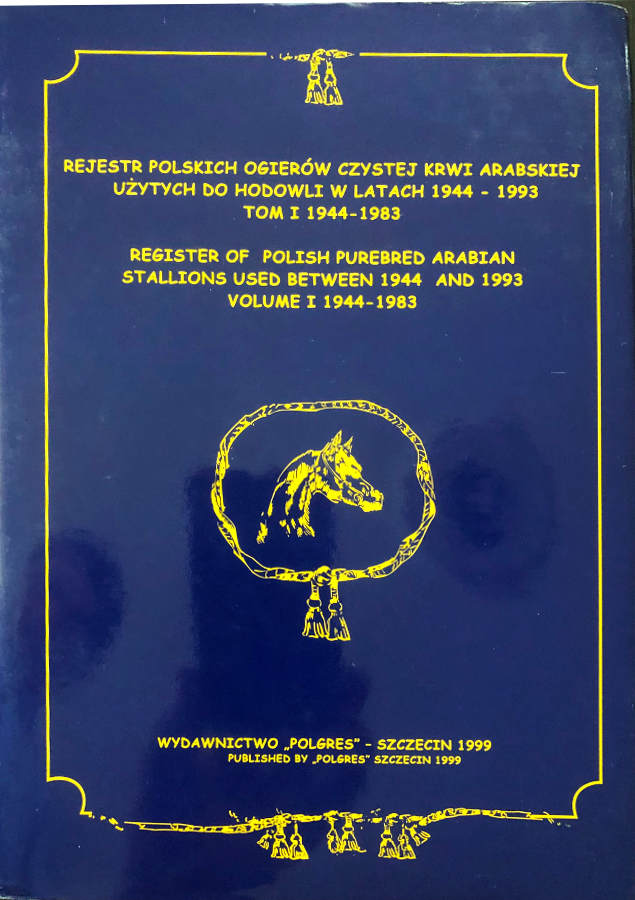ARTICLES
Polish Arabian Stud Book 1926-2020
Registers of historic studs
The beginnings of breeding oriental horses on Polish lands date back to legendary times of
the Polish-Lithuanian Commonwealth, which is as far as the 16th and 17th century. Numerous historic
sources attest to the presence of Arabian horses in Poland. Oriental horses had a large impact on
horse breeding in our country, contributing to the most famous victories of Polish armies. Despite
unfavourable political conditions from the end of the 18th century, several of the largest and
oldest borderland studs survived and maintained a high quality of breeding. Studs of the Sanguszko
family in Chrestówka with its seat in Sławuta in the Volhynia region, the Branicki counts from Biała
Cerkiew in Szamrajówka, Uzin and Janiszówka in the Ukraine and the Dzieduszycki counts in Jarczowce
and Jezupol in the Małopolska region gave the foundation for pedigree breeding of Arabian horses in
Poland. All the later known Polish Arabian horse breedings drew their founding material directly or
indirectly from these studs. They themselves, by means of division of property, dowries and
inheritances, became divided over time into several smaller studs, which by using various sires
drifted away from their maternal studs, however their dam lines always traced back to the family
nest. The turn of the 18th and 19th century was a time when owners of Polish studs, in order to
maintain a high quality of breeding, began organizing excursions to the Middle East in order to
import valuable breeding material directly from the desert. Previously the main source of acquiring
sires were spoils of war and horses imported by dealers or commissioned by breeders. During
1795-1914 a total of 244 original Arabians were imported to Poland, including 215 stallions and 29
mares.
Pedigree from studbook of the
Szamrajówka , 1906
The oldest stud, initially breeding oriental horses and later Arabians, for which credible
historic sources have been preserved, was established in 1778 by the Grand Crown Hetman Franciszek
Ksawery Branicki (1729-1819) in the Szamrajówka farm, part of the Biała Cerkiew estate in the
Ukraine. At the time he imported 30 broodmares and 2 chief sires from the Tulczyn estate of Szczęsny
Potocki, the Kiev voivode. The stud in Tulczyn, since existing earlier, probably had registers or
inventories, but they were most probably taken away by Mieczysław Potocki to Paris in the 30s of the
19th century and until this day remain unavailable to historians. No documents were preserved from
the first period of the existence of the Branicki Stud. A breakthrough year in the stud’s history
was 1803 when a stud book was initiated in Szamrajówka, where not only the amount of the animals was
written down, but also the parentage of the horses. The studs were kept continuously for the next
one hundred years, up until the 1917/1918 revolution when they were lost. Unfortunately, during the
stud’s 100 prosperous years the valuable materials in the books were not used to write down the
history of the stud. The earliest source from that period that has been preserved until our times is
a memo from 1874 by E. Witkowski, the manager of Konstany Branicki’s estate, only roughly describing
the history of the Branicki Stud. A copy of this memo was uncovered by Aleksander Dzieduszycki,
president of the Arabian Horse Breeding Society, prior to the outbreak of World War II from the
archive of the Branicki family and given to Professor Pruski, who in turn handed it over to the
University of Life Sciences Library in Warsaw in 1982. The next authors describing the Biała Cerkiew
studs based their works on this source. In 1913 a commemorative photo album was published, titled
“Szamrajówka Stud 1778-1913”, whose author was probably the then manager of the stud, vet. Feliks
Rozwadowski (1873-1932). A copy of the foreword has been preserved in the archives of Prof. W.
Pruski. The photo album has probably been irrevocably lost. Valuable materials on the Biało Cerkiew
studs have also been provided by a monograph of the studs and at the same time the dissertation of
J. Borowiak from the Wrocław University in 1914, titled “Die Arabische und Anglo-Arabische
Pferdezucht der Grafen Branicki in Białocerkiew”.
In 1820, when the number of broodmares in
Szamrajówka surpassed 100, it was divided into two herds. Part of the core herd remained in
Szamrajówka and the rest was transferred to Uzin, where it remained until the revolution of 1917. As
a result of estate divisions in 1817 a third stud was formed, in Janiszówka, who similarly to the
two previous ones was destroyed in 1918. In the period of more than a 100 year activity of these
studs valuable sire and dam lines were formed, which are represented in our breeding until this day.
Unfortunately after the end of World War I in 1918 the Biała Cerkiew lines were represented by only
two pure bred Arabians. The stallion Wallis 1918 from the sire line of Wernet d.b. and the mare
Arabella from the dam line of Kadi ca.1840, whose line became extinct in 1939. In order to restore
the oldest Biała Cerkiew family the mare Kewa 1923 (Siglavy Bagdady – Kalga) was imported to the
state stud of Janów Podlaski, born at Inocenzdvor Stud in Yugoslavia. She was the 10th generation
deriving from the old Biała Cerkiew family damline of Szamrajówka, born ca.1810. In Janów she
produced 8 foals. Unfortunately as a result of robbery of Janów horses in 1939 Kewa’s daughters –
Oaza 1933, Troska 1937, Włodarka 1939 and Użimka 1939 - found themselves at Tersk Stud and it were
only her granddaughters, purchased to Poland from Tersk, Prowierka 1948 and Piewica 1953, which
continued the family of Szamrajówka in Janów Podlaski and gave the stud its worldwide
fame.
Pedigree of the the mare Cipu, born on
May 2nd, 1903 in the Chrestówka Herd - Sławuta
The second oldest and much more valuable was
the owned by the Sanguszko Princes Chrestówka with its seat in Sławuta in the Volhynia region.
Unfortunately no closer information about the old days of the Sanguszko stud have been preserved.
The information about the first Arabian horse imported to Sławuta in 1790 is not completely
credible. More noteworthy is a memo of Roman Sanguszko (1832-1917) sent to A.G. Szczerbatow, in
which we find an account of the desert bred Arabians imported to Sławuta at the end of the 18
century: “My great-grandfather, Volhynian voivode Hieronim Sanhuszko, sent his equerry Burski to
Arabia for the first time in 1798 to purchase horses”. However this information contradicts the
account of the previous owner of Sławuta, Roman Sanguszko (1800-1881) called “Sybirak” and the uncle
of R. Sanguszko junior, who in 1874 wrote the history of the Sanguszko stud, where he clearly gives
the date of Burski’s expedition to Turkey and Syria as 1803. In the mentioned history of the
Sanguszko stud, published in the 1876 „Encyclopedia of Agriculture” Sanguszko presents the stud's
oldest periods as: “The old Chrestówka herd was a descendant and fragment of the old family herds
and had no date of establishment, because it came from times when the Sanguszko princes, coming from
Lithuania, settled down in the Volhynia region and the Ukraine...”. Since the times of Hieronim
Sanguszko the stud bred solely Arabian horses. Since the times of Hieronim Sanguszko the stud bred
solely Arabian horses. Among the few preserved documents from that era the most credible is a
:stable report" from August 19th, 1799 (Sanguszko archive, 1840).
ASang teka 505.4 s. 2
It gives an insight to the
state of breeding. The report is signed by Michał Rybiński, the stud's manager and attests to very
careful recording of breeding. Rybiński's report is not commonly known. Its fragments together with
a commentary were published by Prince Roman Sanguszko senior in an article in "Encyclopedia of
Agriculture" from 1875. The report was also used by Bolesław Łukomski, who basing on materials from
Sławuta prepared his dissertation in 1906.
Stable report from August 19th,
1799, Sławuta, signed Michał Rybińska (Sanguszko Archives –
Wawel)
The Chrestówka herd gave
rise in 1835 to the stud in Gumniska, established by Władysław Sanguszko, whereas in 1860 as a
result of estate divisions some of the Chrestówka stud was transferred to Wolica, later to Satanów
and then in 1883 as the property of Józef Potocki found its way to Antoniny. In 1820 a stud book was
founded in Sławuta and maintained until 1918, when it was ultimately lost. The extracts from this
stud book, as well as the stud archives of Sławuta and Antoniny, saved during the revolution and in
the hands of the great-grandchildren of Roman Sanguszko, turned out to be invaluable material to
develop the 1st volume of the Polish stud book. A valuable source of information about Polish
Arabian horse breeding in the second half of the 19th century is the published in 1900 in Petersburg
book of the known Russian breeder of Arabian horses, A.G. Szczerbatow - “Kniga ob arabskoj łoszadi”.
The Arabian horse stud in Sławuta was managed continuously for 128 years. The breeding, carried out
with huge knowledge and consistency, created numerous sire and dam lines of great significance for
the Polish Arabian horse. The only Sławuta sire line which has survived both world wars and is
active in Polish breeding till this day is the sire line of Ilderim d.b., imported in 1900 (Eldon –
Piaff – Alert; Pesal – Palatino).
Ilderim or.ar.
ur.1894
Huge significance for Polish and world breeding has the sire line of Ibrahim d.b.,
imported to Antoniny in 1907, prolonged by the famous stallion Skowronek and later restored in
Poland after World War II by importing from the stallions Naborr and Negatiw the USSR. It is
difficult to imagine how Polish breeding would look like without Eukaliptus, the most prominent
until now representative of the Ibrahim d.b. sire line, but there is some concern that this line may
soon again not be represented in Polish breeding.
Ibrahim or.ar.
ur.1899
The documented roots of the Sławuta dam lines date as far as the beginning of the 19th
century and belong to the oldest in Arabian horse breeding in the world, yielding only to
Thoroughbred families. During the last 225 years the Sławuta mares which played a major role in
breeding descended from the following families: family of an unnamed mare - Kobyła ca. 1790,
Szweykowska ca. 1800, Sapieha ca. 1810, Wołoszka ca. 1810, Anielka ca. 1811, Proskurka ca. 1816,
Iliniecka ca. 1820 and Ostrogska ca. 1820. The stud in Sławuta together with its horses and its last
owner Roman Sanguszko ceased to exist on November 1st, 1917. Not one horse survived the revolution.
The Sławuta lines were restored thanks to horses saved from the studs at Gumniska and Antoniny and
those imported from Radutz Stud. The Sławuta traditions were carefully nurtured at Gumniska. In 1836
its owner Władysław Sanguszko established a stud book in Gumniska, which after the war became an
invaluable source for the recreation of the pedigrees of the surviving horses. After the end of
World War I the stud at Gumniska had 8 broodmares and 3 stallions of the Arabian breed. At the
Antoniny Stud of Józef and Roman Potocki 10 stallions and 7 mares survived, including two with
Sławuta brandings. Due to the changes of the Polish border the Potocki family placed their horses at
the Beheń estate in the Volhynia region. The Sławuta lines were represented after World War I in
Polish breeding by three dam lines extinct by 1939 - Iliniecka, Gulowata and Ostrogska and four
families - Szweykowska, Ukrainka, Milordka and Wołoszka - which exist and have been developing in
Poland uninterruptedly for over 200 years.
Gazella or.ar.
imp.1845 Jarczowce ( Juliusz Kossak - arch. K.Olszańskiego )
The third key center for Polish Arabian horse
breeding were Jarczowce of Kajetan Dzieduszycki (1772-1842), located in the Małopolska region. The
stud was established in 1791. A breakthrough moment for this breeding was the purchase of the
stallion Bagdad d.b. in 1840 from the dealer Gliocco and most importantly the import of breeding
material of immense value in 1845 from Arabia. Three imported at the time mares: Gazella d.b.,
Mlecha d.b. and Sahara d.b. established valuable dam lines, existing until this day. The stud at
Jarczowce had an enormous impact on Polish breeding thanks to the talent and passion of Juliusz
Dzieduszycki, who encouraged many breeders to breed Arabian horses by his example.
Gazella or.ar. imp.1845 Jarczowce (
Juliusz Kossak - arch. K.Olszańskiego )
After the death of Juliusz Dzieduszycki (1817-1885) the stud was
transferred by his successors to Jezupol, where the family tradition was continued by Władysław
Dzieduszycki. During the first war the stud suffered great damage. Only several mares survived:
Pomponia 1902 with daughter Zulejma 1914 from the line of Sahara d.b. and Gazella II 1914 from the
line of Gazella d.b. The mares found their way to the Mordy estate near Siedlce. Thanks to the
efforts of the then General Inspector of the State Studs, Jan Grabowski, they were exchanged for
draught horses and came to Janów Podlaski State Stud where in 1919 an Arabian department was
established. The Jarczowce mares founded valuable families in Janów, which were preserved after
World War II and even further developed.
Sahara
or.ar.imp.1845 Jarczowce (Juliusz Kossak - z arch. K.Olszańskiego)
Apart from the three
mentioned dam lines in Jarczowce also established was the incredibly valuable sire line of Krzyżyk
d.b. From this line World War I was survived by the stallions Abu Mlech 1902 and Farys II 1905. The
line was prolonged in Janów by Abu Mlech and is currently represented in Polish breeding by the get
of Trypolis. The stud at Jarczowce, despite breeding excellent horses, could not however boast a
properly managed stud book. That's why, after the turmoil of war, the recreation of the pedigrees of
the Jarczowce horses was very problematic and in some cases not possible. Helpful in these cases
were the stud books published in lands under Russian and Austrian rule, where many breeders
registered their horses up until the end of the 19th century. They became a valuable source for the
documentation of pedigrees of horses that survived the war.
The first Arabian stud book published in
Russia was the developed by Aleksander Szczerbatow and published in 1903 "Zawodskaja kniga arabskich
łoszadiej w Rossiji". It included 44 stallions and 228 mares, among them those from Antoniny and
Sławuta.
In 1867
in Vienna captain Otto Mayr published a stud book titled " Allgemaines Osterreichisches und
Ungarisches Gestut-Buch" in which beside Thoroughbreds he placed the parentage of Arabian horses
bred in the Austro-Hungarian Empire. In 1899 in Małopolska the first Polish Arabian stud book was
published by the Galician Horse Breeding Society, developed by Kazimierz Ostoja-Ostaszewski titled
"Oficjalna księga stadna koni orientalnych dla Galicji i Bukowiny". This stud book included 8
stallions and 62 mares with the pedigree tables of the produce of mares imported by Juliusz
Dzieduszycki in 1845: Gazella d.b., Mlecha d.b. and Sahara d.b. In 1909 the Galician Livestock
Society in Lviv published the "Księga stad orientalnych i półkrwi" developed by Władysław
Dzieduszycki and Marian Jędrzejowicz. The stud book included pedigree tables of stallions which
played a significant role in breeding in the Małopolska region. During 1910-1912 two supplements to
the stud book were published. At the beginning of the 20th century two interesting publications of
Stefan Bojanowski were printed, describing the famous borderland studs: " Za końmi na Wołyń i
Ukrainę" and "Sylwetki koni orientalnych i ich hodowców", as well as several interesting articles in
the "Rider and Hunter" magazine. In 1906 B. Łukomski published the monograph "Das arabische Pferd in
Sławuta". All these above mentioned publications served as source material for the creating of the
1st Volume of the Polish Arabian Stud Book in 1924-1926, which was eventually published in 1926
under the editorship of Edward Skorkowski.
The 1st Volume of the Polish Arabian
Stud Book
World War I brought enormous material loss
for Polish lands. Among the numerous fields of social and economic life there were also great losses
in Arabian horse breeding. From the 500 broodmares from before the first war only 10% survived.
According to Z. Rozwadowski in 1918 there were 25 mares with their produce (13 foals: 6 colts and 7
fillies) on Polish soil. The mares came from 14 dam lines: Gazella, Mlecha, Sahara, Elsissa,
Milordka, Ukrainka, Szweykowska, Iliniecka, Gulowata, Wołoszka, Kadi, Szamrajówka, Wisznia and
Ostrogska, as well as 12 sire lines: Abu Urkub II d.b., Aghil Aga d.b., Antar d.b., Arslan d.b.,
Druid d.b., Ezrak Seglavi d.b., Gessur d.b., Hermit d.b., Krzyżyk d.b., Kubiszan d.b., Seglavi
Ardżebi d.b.and Ilderim d.b.
A regrettable loss was the complete extinction of the oldest Polish
studs on the former eastern borderlands, especially Sławuta, Biała Cerkiew and Antoniny, as well as
great damages to studs located in the Małopolska region, through which war activities also passed.
Another huge loss was the disappearance of the several hundred year old archives and stud books of
those studs. However despite these difficult conditions already in 1918 in the Ministry of
Agriculture and Crown Estates a provisional State Stud Board was set up, whose task was to quickly
restore the breeding of horses, also Arabians. From the very beginning it was understood that the
breeding documentation had to be put to order by developing and publishing a stud book. The
establishing of a stud book for Arabians and organizing races for them was actively taken up by
Edward Skorkowski and it was him that the Ministry of Agriculture assigned this task to in 1924. The
second person that took active part in the organization of publishing the Polish stud book was
Aleksander Dzieduszycki (1874-1947), later the esteemed president of the Polish Arabian Horse
Breeding Society and Bogdan Ziętarski, a superb breeder with great services to breeding and
organizing Arabian races in Poland.
On May 1st, 1924 the Ministry of Agriculture issued a regulation on the
official publication that was the "Polish Arabian Stud Book". During works on the stud book
corrections to the rules of maintaining the stud book were needed. New rules were published on
October 8th, 1926. According to this regulation the stud book consisted of two sections: the first
had horses approved by a special commission as pure bred and the second had horses with at least 50%
pure Arabian blood. Entries to the stud book were accepted up to December 31st, 1925. After this
date only those horses were registered that were either approved by the stud book's commission as
Arabian or were the produce of both parents registered in either one of the two sections. The 1st
volume of the Polish Arabian Stud Book included 56 mares and 84 stallions. "(...) those 56 mares are
the foundation of Polish Arabian horse breeding, which it descends from - it cannot die, since it
gave Melpomena and Skowronek..." wrote Edward Skorkowski in his foreword to the first volume.
The second section had 222 mares and 205 stallions. Horses registered in the stud book belonged to
36 owners. The stud book also included 70 pedigrees of horses most merited in breeding, reaching six
generations back. Difficulties during the development the 1st volume in completing source materials
of the parentage of some horses, especially in further generations, caused that in 1930 a decision
was made to reorganize the stud book, establishing two separate ones in the Arabian breed - for pure
breds and those bred in "pureness of blood". The pure blood stud book included horses from the
previous first section, excluding those whose pedigrees were not confirmed deeply enough or that
showed any trace of non-Arabian blood. The regulation of the Ministry of Agriculture in this matter
was published on December 4th, 1931. It included the final rules for the maintaining of the Polish
Arabian Stud Book and according to them eligible for registration in the stud book are:
- stallions and mares of pure Arabian blood imported from Arabian (desert bred)
- stallions and mares of pure Arabian blood imported from other countries
- stallions and mares whose ancestors either fulfill the requirements mentioned in points 1 and 2 or can be traced to horses from the following Arabian studs existing before November 11th, 1918: Antoniny of the Potocki family, Białocerkiew of the Branicki family, Jarczowce of the Dzieduszycki family - as long as among the ancestors of horses from these studs are no horses with other blood than Arabian or horses whose parentage is considered by the stud book commission as insufficiently proven;
- stallions and mares whose parents - each separately - fulfill one of the requirements listed in points 1, 2 or 3 above.
The most Arabian broodmares registered in the 1st volume of the stud book had in that time
the state stud of Janów Podlaski - 13, next Roman Sanguszko in Gumniska - 8, Józef and Roman Potocki
in Beheń - 5, Witold Czartoryski in Pełkinie - 5. These numbers show that the condition of Polish
breeding in 1925-1926 was very modest. Despite this breeders understood the need of joint actions
and on October 4th, 1926 they established the Arabian Horse Breeders Society. The Society took over
from the Ministry of Agriculture the maintaining and publishing of the Arabian and Anglo-Arabian
stud book and since that time until 1939 published subsequent supplements to volume 1. In 1932 the
1st Polish Arabian Stud Book was published in print. The stud book included 105 broodmares with
their produce, 95 stallions and 86 pedigrees reaching 7 generations back. Up until the outbreak of
World War II six supplements were published and in 1938 the 2nd volume of the Polish Arabian Stud
Book was published. Volume two included 176 mares with produce belonging to 62 owners and 43
sires.
After World War II - the building of the Polish breeding
program
The outbreak of World War II found Polish Arabian breeding on a good developmental path
and very high quality of the possessed horses. From the 166 mares registered in the stud book in
1939 as many as 143 were lost or robbed. The greatest losses were suffered by the state stud in
Janów Podlaski, which in 1939 lost 90% of its breeding material. The retreating in October Soviet
army, which attacked Poland on September 17th, took with them the entire stud, which was placed in
Tersk in the Caucasus. The Janów horses never returned to Poland, becoming a foundation for the
famous Arabian horse breeding of the USSR. The foundation for the restoring of the Janów herd turned
out to be the youngsters lost during the evacuation of the stud, as well as Janów-bred horses and
their produce repurchased from private breeders. During 1939-1944 several private breeders were able
to survive and maintain their breeding activity, among them the Gumniska Stud of Roman Sanguszko and
the stud in Pełkinie of Witold Czartoryski. During 1939-1947 the Arabian Horse Breeding Society did
not stop being active. The Polish Arabian Stud Book was published in the form of annual supplements
to volume II, which appeared 10 in total. In 1944 the occupational German authorities retreating
before the coming front ordered an evacuation of Polish breeding horses to Germany. In this group
was the Janów Podlaski Stud and horses from Młynów-Ołyka, which at the beginning of 1945 were found
near Lubeck. The group also included Arabian horses from the stud in Stare Sioło, established during
the occupation, evacuated to the Czechoslovakian territory. The end of the war found them in
Topolcanky stud. Thanks to the huge devotion and dedication of people who accompanied Polish Arabian
horses in their war wanderings, in 1946 to Poland returned 39 mares, 12 foals and 3 Arabian
stallions from Germany, including the repurchased from the serum factory mares from Babolna Stud and
10 mares and 2 stallions that returned from Topolcanky. In total the amount of horses that were
rescued after World War II for Polish breeding were 59 mares and 8 Arabian stallions. Once again
everything had to be started from the very beginning.
Upon ending war activities Polish breeding
came to another history curve. The country was freed from German occupation, but for the next 45
years was under Soviet influence. The change in the political system did not favor the development
of Arabian horses. During 1946-1947 reclaimed to Poland from the British occupational zone were 1600
Polish breeding horses and 600 personnel. This group included 39 mares and 3 Arabian stallions from
the Janów Stud, which played a fundamental role in creating Polish Arabian horse breeding after
World War II.
In
the introduction to volume 3 of the Polish Arabian Stud Book, its editor Edward Skorkowski described
the condition of breeding during 1939-1947 as: "(...) we are in a much better place than after World
War I, we have an organization, a stud book and performance trials and first of all 25 years of
experience, which we did not have when restoring the previously ruined Arabian horse breeding."
Volume 3 included data from 1939-1947 and 241 mares and 19 sires. The list of data depicts the
losses suffered by Polish breeding in the war years:
1) exported in 1937 and 1938 - 8
2) lost during war activities
a)
1939 - 79
b) 1941 - 13
c) 1944 - 9
d) 1945 - 42
3) exported to the US in 1945 - 2
4) robbed - 6
5) died - 20
6) eliminated from breeding - 10
____________________________
lost from
breeding-189
left in breeding-59
The gathered breeding material allowed to
recreate Polish Arabian breeding after World War II. Due to the confiscation of private property by
means of decrees of pro-Soviet authorities, also Arabian horses found themselves under the sole
property of the government. This state of affairs was maintained in Poland until the second half of
the 80s, when the communist authorities allowed to own Arabian mares by private persons. The
creation of Arabian state studs in Poland after 1945, although with harm to private breeders, became
the beginning of a unique breeding program. Mares which survived World War II and became the
foundation of today's Polish state breeding were the property of 14 breeders. Janów Podlaski, the
only state stud prior to the second war, became one of three and later four state studs. The
confiscation of private property in favor of the state was difficult to accept, yet it created
unique situation allowing to carefully coordinate actions for the entire state breeding. A joint
breeding program, created by a group of Arabian horse experts, caused the breeding of Arabian horses
in Poland not only to survive but to develop, achieve world successes and become a good example to
follow.
By the
decision of the authorities in 1948 the Arabian Horse Breeding Society was liquidated and the
maintaining of the stud book was handed over to the state racecourse under the auspices of the
Ministry of Agriculture, which lasts until today. The 4th volume of the Polish Arabian Stud Book was
published in 1953. Subsequent volumes together with their supplements were published regularly each
4-5 years. In 1959 a regulation was issued which made corrections to the rules of registering
horses, namely that: "Entered into the Polish Arabian Stud Book are stallions, mares and foals
which:
1) were imported from the countries of the Arabian
Peninsula or other countries and are considered to be pure bred Arabian horses
2) possess in all lines ancestors fulfilling the requirements set in
point 1 or can be traced from horses registered in the Polish Arabian Stud Book maintained since
1932.
Upon
creating the World Arabian Horse Organization (WAHO) in 1970 in London all stud books were inspected
for approval, including the Polish one. A special WAHO commission came to Poland and after learning
the methods of maintaining the stud book considered the Polish one an example by which WAHO
developed international rules of maintaining stud books.
The change of the political and economic
situation in Poland after 1989 did not affect the way of maintaining and financing the PASB. Hi-tech
methods in reproduction and breeding, such as artificial insemination and embryotransfer, required
the clarification of rules in this matter. There was also a need to change the rules of
registration. According to WAHO, an Arabian horse is such that is registered in a WAHO-approved stud
book.
Genealogical tables, Stallion register, Pruski
In 1960 and 1972 the genealogical tables
of E. Skrokowski ("Polskie tablice genealogiczne koni arabskich czystej krwi") were reprinted with a
foreword in four languages. Also in 1972 the genealogical tables of Zdzisław Rozwadowski (in
English) were published, titled "50 years of breeding pure blood Arabian Horses in Poland in their
genealogical charts 1918-1968", edited by Antoni Święcki, funded by Leon Rubin from the US - a great
friend of Polish breeding. The tables of Z. Rozwadowski, as an incredibly comprehensive newest
history of Polish Arabian horse breeding, were called the "bible" of the Polish Arabian horse. With
a full history of Polish breeding and Arabian horse studs, illustrated with photographs of merited
horses, they include the parentage of all horses that were present in Poland in 1918-1968,
descending in a straight line from 38 founding mares and 29 founding stallions. During 1974-1985
four supplements were issued, whose author after the death of Z. Rozwadowski in 1977 was Roman
Pankiewicz. Supplement V was published in 1987. Supplements I and II were funded by Leon Rubin,
supplement III - by the American Lasma Stud, supplement IV - by Lasma Arabians and Arabian Horse
World magazine, in cooperation with Jolanta and Zenon Lipowicz. In 1983 Professor Witold Pruski
published the vital for discovering the history of Polish Arabian horse breeding work titled " Dwa
wieki polskiej hodowli koni arabskich (1778-1978) i jej sukcesy w świecie". This extremely colorful
and carefully prepared book is until this day the basic source of knowledge on Polish Arabian horse
breeding. It also documents all sources and breeding archives which allowed to create the Polish
Arabian Stud Book. An interesting addition to the information included in Prof. W. Pruski's book is
the published in 2007 work of Prof. Krystyna Chmiel "One tworzyły piękno", depicting the profiles of
the most merited mares, which after 1939 gave rise to dam lines active till this day, descending
from the old historic studs. Published in 1999 was the extremely valuable register, titled "Rejestr
polskich ogierów użytych w hodowli w latach 1944-1983", developed by Roman Pankiewicz. The 1st
volume of the register covers the years 1944-1983, key to the restoration of Polish breeding after
World War II in its current state.
The
publisher of volume I is the private Arabian stud "Wyspa Wolin" of Dionizy Szostek. The uniqueness
of this work for today's breeders is that it includes the spot-on comments and opinions of breeders
from that era, mainly Andrzej Krzyształowicz and Ignacy Jaworowski. The key significance of the
register is the incredible knowledge and passion of its author, Roman Pankiewicz, who passes it on
to the next generation of Polish breeders. The second volume of the register covers the years
1983-1993 and was developed by Roman Pankiewicz and Agnieszka Mikulska and published by Michałów
State Stud in 2005.
The dedication placed on
the opening page of the second volume of " Rejestru polskich ogierów czystej krwi użytych w hodowli
w latach 1944-1993" may be considered the tagline of this article: "(...) In memory of Prince Roman
Sanguszko and Bogdan Ziętarski, thanks to whom Arabian horse breeding has been enriched with the
sire lines of Kuhailan Haifi, Kuhailan Afas and Kuhailan Zaid". The respect for the history and our
great predecessors allowed Polish breeding to stand back up after many falls. To remain and develop,
giving joy and satisfaction to subsequent generations of Polish breeders, bringing fame to Poland
all over the world.
Author: Hanna Sztuka




